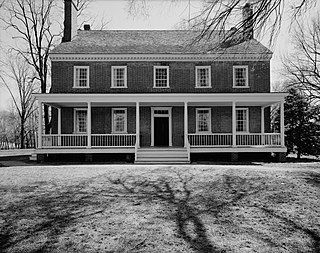
Historic Locust Grove is a 55-acre 18th-century farm site and National Historic Landmark situated in eastern Jefferson County, Kentucky. The site is owned by the Louisville Metro government, and operated as a historic interpretive site by Historic Locust Grove, Inc.

Abraham Lincoln Birthplace National Historical Park is a designated U.S. historic park preserving two separate farm sites in LaRue County, Kentucky, where Abraham Lincoln was born and lived early in his childhood. He was born at the Sinking Spring site south of Hodgenville and remained there until the family moved to the Knob Creek Farm northeast of Hodgenville when he was two years old, living there until he was seven years of age. The park's visitor center is located at the Sinking Spring site.
Mordecai Lincoln was an uncle of U.S. President Abraham Lincoln. He was the eldest son of Captain Abraham Lincoln, a brother of Thomas Lincoln and Mary Lincoln Crume, and the husband of Mary Mudd. Lincoln is buried at the Old Catholic or Lincoln Cemetery near Fountain Green, Illinois.

Lincoln Boyhood National Memorial is a United States presidential memorial and a National Historic Landmark District in Lincoln City, Indiana. It preserves the farm site where Abraham Lincoln lived with his family from 1816 to 1830. During that time, he grew from a 7-year-old boy to a 21-year-old man. His mother, Nancy Hanks Lincoln, and at least 27 other settlers were buried here in the Pioneer Cemetery. His sister Sarah Lincoln Grigsby was buried in the nearby Little Pigeon Baptist Church cemetery, across the street at Lincoln State Park.

This is a list of properties and historic districts in Kentucky that are listed on the National Register of Historic Places. There are listings in all of Kentucky's 120 counties.

The Zachary Taylor House, also known as Springfield, was the boyhood home of the twelfth President of the United States, Zachary Taylor. Located in what is now a residential area of Louisville, Kentucky, Taylor lived there from 1795 to 1808, held his marriage there in 1810, and returned there periodically the rest of his life.

Blackacre State Nature Preserve is a 271-acre (110 ha) nature preserve and historic homestead in Louisville, Kentucky. The preserve features rolling fields, streams, forests, and a homestead dating back to the 18th century. For visitors, the preserve features several farm animals including horses, goats, and cows, hiking trails, and a visitor's center in the 1844-built Presley Tyler home. Since 1981, it has been used by the Jefferson County Public Schools as the site of a continuing environmental education program. About 10,000 students visit the outdoor classroom each year.

The Greene County Almshouse is a historic poorhouse located in Greene County, Illinois, along a township road northeast of the city of Carrollton. The almshouse was built in 1870 in accordance with an 1839 state law which provided for each county to establish its own almshouse or poor farm for welfare recipients. Prior to passage of the law, public welfare in Illinois had taken the form of "outdoor relief", in which the poor worked on farms in exchange for basic support. Under Illinois' county almshouse system, the poor were intended to receive shelter and necessities in the houses, often in exchange for farm labor on the property. By 1903, all but two of Illinois' counties had established an almshouse or poor farm.
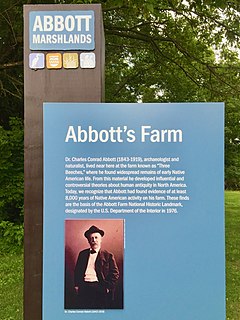
The Abbott Farm Historic District is a National Historic Landmark archaeological site in New Jersey. It is the largest known Middle Woodland village of its type on the East Coast of the United States. Significant evidence suggests that the Delaware River floodplain was occupied by Paleoindian people for a long period. It was inhabited between 500 BC and 500 AD. It has been a source of controversy and debate around early development.

List of the National Register of Historic Places listings in Mercer County, New Jersey
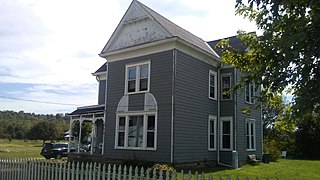
James Rogers House in Belleview, Kentucky is a Queen Anne-style farmhouse built in 1903. It was listed on the National Register of Historic Places in 1989.

Edgemoor Farm Dairy Farm was built as part of a dairy farm in 1913 in Santee, California. Edgemoor was part of a Spanish land grant to Maria Antonio Estudillo who married Miguel de Pedrorena, a native of Madrid. By the 1850s, through a variety of ways, individuals obtained portions of the grant and began to farm. Walter Hamlin Dupee purchased Edgemoor Farm in 1913 and built it into a national award-winning dairy farm, polo pony ranch and early tourist attraction.
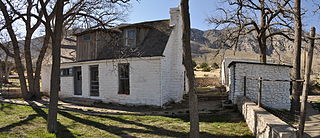
The Frijole Ranch, also known as Guadalupe Ranch, Spring Hill Ranch and the Rader-Smith Ranch, is located in Guadalupe Mountains National Park in extreme west Texas. It was listed on the National Register of Historic Places on November 21, 1978, and represents a significant period in the settlement and ranching of the Guadalupe Mountains.

The Oliver Whiting Homestead is a historic farmstead on Old County Farm Road in Wilton, New Hampshire, just south of the County Farm Bridge. The 72-acre (29 ha) property was one of the region's largest dairy farms in the early 19th century, and it was used as Hillsborough County's poor farm between 1867 and 1896. The main focus of the property is a large Federal-style brick house built c. 1800 by Oliver Whiting; it also has an 1846 Gothic Revival barn which predates the establishment of the poor farm. The property was listed on the National Register of Historic Places in 1982.

The Insane Asylum at the County Poor Farm is a historic building located north of Andrew, Iowa, United States. It is one of over 217 limestone structures in Jackson County from the mid-19th century. Built in 1872, this 2½-story structure is composed of stone blocks that vary somewhat in shape and size, and they were laid in courses. Because of its late date compared with the other historic stone buildings in the county, it features segmental arches instead of lintels. By the time it was built limestone construction in the county had already reached its peak. Adam Strasser and Frank Schlecht were contractors from Bellevue, Iowa who were responsible for its construction, as was local stonemason John Weis. The other 19th-century buildings from the poor farm have been removed, and replaced by the county care facility across the highway. This building is now part of a demonstration farm. It was listed on the National Register of Historic Places in 1992.

The First Johnson County Asylum is a historic building located on the far west side of Iowa City, Iowa, United States. The first facility Johnson County built to care for paupers and the mentally ill was a four-room cabin in 1855. Two wings were added to the original building six years later. All that remains of this structure is this wing that housed the mentally ill. The single-story wood-frame structure with a gable roof was used by the county for this purpose until 1886 when a new facility was completed. It was initially thought that it was built in 1859, but later research revealed that it was built in 1861 and that it was moved a short distance to this location in 1888. This building served for many years as a hog building on the Johnson County Poor Farm. It is now part of an education-based farm program called Grow:Johnson County. The building was individually listed on the National Register of Historic Places in 1978. In 2014 it was included as a contributing property in the Johnson County Poor Farm and Asylum Historic District.
The Jacob Hunter House near New Liberty, Kentucky is a historic Federal vernacular-style house built in 1818. It was listed on the National Register of Historic Places in 1987.
The John Cox House, in Hopkins County, Kentucky near Nebo, Kentucky, was built in 1875. It was listed on the National Register of Historic Places in 1988.

Fernbrook Farms is a 230-acre (93 ha) working farm located along County Route 545 in Chesterfield Township in Burlington County, New Jersey. Originally an 18th-century farm, it was briefly a stock breeding farm, known as the New Warlaby Stock Farm, in the 19th century. It now includes an inn, plant nursery, environmental education center, and community-supported agriculture. It was added to the National Register of Historic Places on July 7, 2022, for its significance in architecture and landscape architecture.
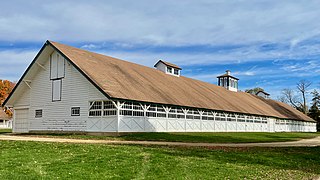
Brookdale Farm is a former Thoroughbred breeding and training farm located at 805 Newman Springs Road in the Lincroft section of Middletown Township in Monmouth County, New Jersey. Thomas Lloyd acquired the property in the late 18th century. In 1872, David Dunham Withers established the horse breeding and training operation. By 1889, the farm included 838 acres (3.39 km2). In 1968, 215 acres (0.87 km2) of the farm were bequeathed by Geraldine Morgan Thompson to the county to create Thompson Park.


















